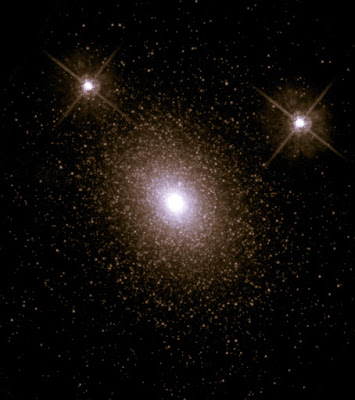Page 1 of 1
G1 globular cluster in M31
Posted: Thu Nov 19, 2015 3:16 am
by Glima49
So I processed some HLA data of this globular cluster recently and created this image:

One interesting thing about this globular cluster is its ellipsoid shape. The globular cluster Omega Centauri which belongs to the Milky Way is more spherical. I'm not sure if this is typical for globulars or not. Does anyone know of another globular cluster with a shape similar to this? I know of the large globular cluster NGC 121 in the SMC, but not a lot else. I don't know a whole lot about globular clusters and I'm a new user, so hello!

Thanks for answering.
Re: G1 globular cluster in M31
Posted: Thu Nov 19, 2015 4:18 am
by neufer
https://en.wikipedia.org/wiki/Globular_cluster wrote:
<<Although globular clusters generally appear spherical in form, ellipticities can occur due to
tidal interactions. Clusters within the Milky Way and the Andromeda Galaxy are typically oblate spheroids in shape, while those in the Magellanic Clouds are more elliptical.>>
Code: Select all
Galaxy Ellipticity
--------------------------------------
Milky Way 0.07±0.04
M31 0.09±0.04
LMC 0.16±0.05
SMC 0.19±0.06
http://adsabs.harvard.edu/abs/2005AAS...20712811C wrote:
On the Origin of the Ellipticity of Globular Clusters: The Isolated Cluster in the Low-Mass dIrr Galaxy WLM
Catelan, M.; Stephens, A. W.; Contreras, R. P.
<<Globular clusters have long been known for presenting (at times) significant deviations from spherical symmetry. While
rotation has been the main proposed explanation, other complicating factors such as their constant interaction with the strong gravitational potential of their host galaxy have made it difficult for a consensus to be reached. To address this question we have obtained high-resolution VLT/UVES spectra of WLM-1, the lone globular cluster associated with the isolated, low-mass dwarf irregular galaxy WLM. We will present the results of our study, including rotation velocities along both the semi-major and semi-minor axes, as a test of the rotation hypothesis.>>
http://www.astrolandofoz.com/GlobularClusters.html wrote:
<<M-19 (NGC-6273): A bright globular cluster in Ophiuchus, discovered by Messier in 1764. M-64 is one of the most oblate of all the globular clusters. This elongated shape is mainly caused by the
extinction of light from the eastern edge of the clustr by intervening dust and gas. This cluster lies 28,000 light years from earth and is 140 light years in diameter.>>
Re: G1 globular cluster in M31
Posted: Thu Nov 19, 2015 4:20 am
by Glima49
Thanks for letting me know neufer!

Re: G1 globular cluster in M31
Posted: Thu Nov 19, 2015 6:38 pm
by starsurfer
Glima49 wrote:So I processed some HLA data of this globular cluster recently and created this image:

One interesting thing about this globular cluster is its ellipsoid shape. The globular cluster Omega Centauri which belongs to the Milky Way is more spherical. I'm not sure if this is typical for globulars or not. Does anyone know of another globular cluster with a shape similar to this? I know of the large globular cluster NGC 121 in the SMC, but not a lot else. I don't know a whole lot about globular clusters and I'm a new user, so hello!

Thanks for answering.
Some globular clusters in the LMC have a similar shape but I don't remember which ones.
Re: G1 globular cluster in M31
Posted: Fri Nov 20, 2015 12:43 am
by Ann
Welcome, Glima49!
I googled flattened clusters and found
this paper by C.W. Chen and W. P. Chen:
Abstract
The shapes and sizes of 116 Galactic globular clusters (GCs) are presented, based on the analysis of the spatial distribution of 2MASS point sources. In general, Galactic GCs are slightly flattened in shape, with a median axial ratio of 0.87. The GCs close to the Galactic bulge have various degrees of flattening, and those exhibiting obvious flattening tend to have their elongation pointing toward the Galactic center, manifesting the tidal effect from the bulge. In comparison, GCs away from the Galactic center tend to be spherical. A few GCs in the halo are also found to have elongated shape. Three notable cases of highly flattened clusters were previously known to be associated with stellar streams or particular dynamical history: NGC 5897 is known to have a stellar tidal tail extending to its equatorial north and south; NGC 6838 had a recent encounter with the Galactic plane; and IC 4499 is spatially close to, and collimated with, the "Magellanic Stream." We also found 31 GCs associated with possible clumpy structures in stellar distributions, as diagnosed by possible cluster members selected by colors and magnitudes. Four such cases of stellar debris are presented: NGC 6366 is experiencing heavy tidal stripping and NGC 2808 has been known to have multiple main-sequence branches. NGC 3201 and NGC 6397, like the flattened cluster, NGC 6838, also have their recent passage through the Galactic plane. Our sample is derived from the most inclusive analysis of the morphology of Galactic GCs, and should provide a valuable database to probe the mass distribution, or merging history of the Milky Way galaxy.
Ann



